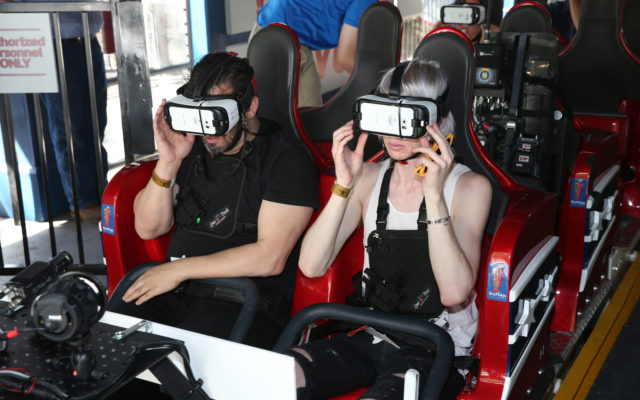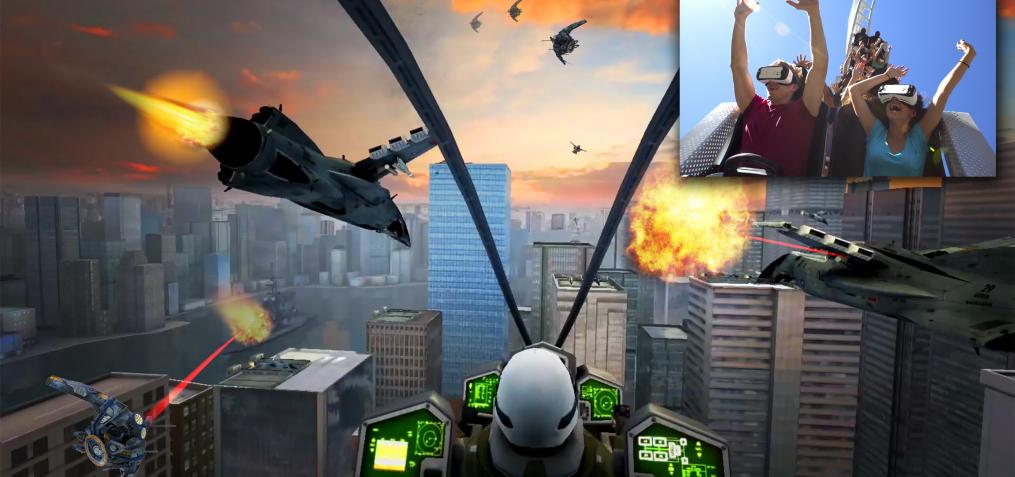Although there are plenty of options for VR hardware, not everyone can afford them or are willing to bring this new technology into their homes. Instead, it makes more sense to head out to arcades and theaters for a taste of VR. Here’s how brands are getting creative with immersive entertainment and taking VR to the streets.
Franchise Immersion
What if, before you saw the next Harry Potter movie, you could challenge your friends to a quidditch match? Or after seeing Batman, you could explore Gotham City? Well, location-based VR experiences like these may be coming to a movie theater near you. In fact, the Assassin’s Creed VR Experience is touring AMC theaters right now.
IMAX recently partnered with VR creator, publisher and distributor, Starbreeze to bring location-based virtual reality experiences to cinemas across the world. Starbreeze regularly partners with filmmakers to create original virtual reality content such as John Wick Chronicles and Overkill’s The Walking Dead. IMAX will create a premium VR experience that will leverage Starbreeze’s StarVR headset technology, which provides a 210-degree full peripheral field of view—double that of any other VR headset currently available. It’s tech offerings like this that sets location-based VR experiences apart from its home entertainment counterparts.
“The price of the initial investment of a head-mounted display and PC that powers the headset aside,” Emmanuel Marquez, chief technology officer at Starbreeze explained to [a]listdaily, “you already have challenges with finding that spot in the house where you can move around in VR without getting your knees bruised from bumping into furniture. There are so many great accessories and setups today that enhance your experience that just wouldn’t be viable to put in a home. We can cater to that.”
The partnership between IMAX and Starbreeze makes these experiences affordable and easily accessible to those who are already in the mood for consuming entertainment. Other memorable location-based VR experiences include Suicide Squad and American Horror Story at San Diego Comic-Con and Madam Tussauds Ghostbusters: Dimension hyper-reality experience.

Upgraded Experiences
Theme parks have already adopted virtual and augmented reality experiences for their attractions, such as Six Flags and Cedar Point. In Six Flags’ The New Revolution Virtual Reality experience, ride-goers strap on VR headsets and engage in a futuristic battle to save the planet from an alien invasion. With The Battle For Cedar Point, attendees can join different roller coaster-themed clans to compete with each other by scanning different areas of the park with their smartphones, such as signs and special t-shirts, for an augmented reality experience. The technology essentially turns the theme park into one gigantic video game. At the end of the day, members of the winning clan can purchase a special pin to commemorate their victory.
While braving a roller coaster may be fun on its own, adding a VR headset to the mix can create an entirely unique adventure each time, eliminating the need to build a new attraction. For example, Six Flags has a dedicated VR coaster that gets new adventures as the opportunity arises, such as the Superman: Ride of Steel attraction this past summer.

Playing Together
VR Arcades are popping up around the globe, finding a particularly booming industry in China. These businesses offer a range of immersive, group entertainment from interactive games to virtual rocket rides. In October, HTC unveiled its Viveport Arcade system, creating a revenue-sharing marketplace for public entertainment centers to access the latest interactive titles.
“VR has found a home with Chinese players as the majority of the market do not have the capability to support home based VR and already are happy to play their PC games in LAN Game centers sometimes called PC Bang sites,” Rikard Steiber, president of Viveport and senior vice president of VR at HTC, told Polygon. “Amusement venues and location-based entertainment sites have also grown in popularity in the Asian Dragon market—so it was logical that VR Arcades would be embryonic within this incubator.”
Analysts expect the market for virtual reality in China to grow to $8.5 billion by 2020, benefiting largely by the $1.1 billion global VR spending spree.
China is not the only country adopting this idea—Bandai Namco, the publisher behind Pac-Man and Tekken, has opened its own HTC Vive arcade in Japan called VR Zone: Project i Can. Among a number of available games is a terrifying, immersive challenge in which users must rescue a cat from a plank suspended on the side of a skyscraper. The combination of VR and environmental elements creates a sense of “being there,” a feat not usually possible in a home entertainment setting.

